ZOIA review: A complex and rewarding modular effects pedal
Empress Effects built a one-of-a-kind, bottomless guitar pedal that can be a little daunting.
The world of guitar effects is weird. It’s a place where old-school analog gear and crazy high-tech digital pedals are both fetishized with the same amount of zeal. Some companies, like Empress Effects, even try to straddle both worlds simultaneously. Its earliest pedals, like the Empress Tremolo, were largely analog affairs, with some digital smarts hanging around the periphery of the signal path. Some of its later pedals, like the Reverb and Echosystem, though, fully embraced the digital world. They’re deep-effects stations with an insane number of features and plenty of unique sounds. They are also part of an increasingly popular type of effects processor that tries to cram the complexity and richness of a rack-mount unit into something small enough to fit on a pedalboard.
But part of what Empress has built its reputation on is a willingness to innovate and experiment. For its newest pedal, the ZOIA, it created something that doesn’t fit neatly into the category of “effect pedal.” It certainly looks like one. And it certainly can be used as one. But Empress actually bills the ZOIA as “a modular synthesizer in pedal form.” That’s not a bad description, because while the ZOIA is clearly built for guitarists, its core functionality is much closer to that of a modular synth. (To be clear: The ZOIA plays just as well with a synth as it does a guitar.)
In some ways the ZOIA is not unlike Critter & Guitari’s Organelle. It’s a do-it-all music-making box that lets people build their own effects, synths and loopers. Like the Organelle, it rewards patience. But that’s where the similarities end. For one, the Organelle is a keyboard-based instrument, not a pedal — obviously. And while the Organelle M asks you to connect a monitor, mouse and a keyboard to build patches in Pure Data, the ZOIA requires no coding. Instead you place and connect modules using the five-by-eight grid of RGB pads on the front.
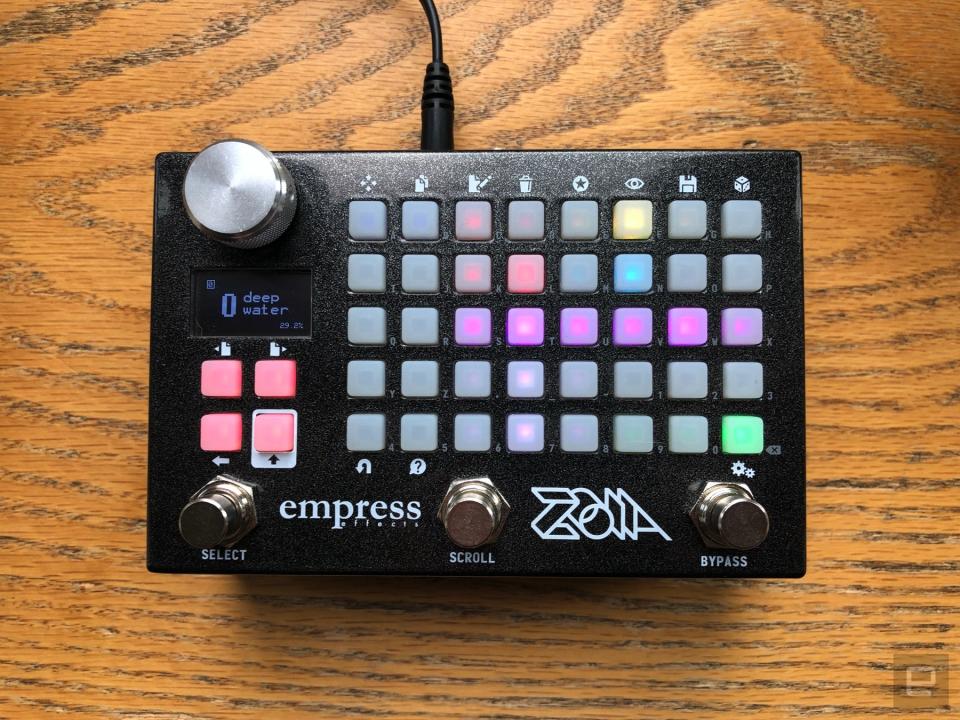
You can certainly plop down an audio-in module and an audio-out module and stick a reverb between them, but the ZOIA’s real power is in getting the various tools and effects to interact with one another in new and interesting ways. And many of the modules are not your standard guitar-effects fare; they’re far more likely to be found on a synthesizer, like the LFO, ADSR (attack, decay, sustain, release) and slew limiter.
If you’ve never dabbled in the world of modular synths, the ZOIA can be a bit intimidating. At first blush it’s a bewildering array of lights and buttons. And while it comes preloaded with 64 presets, it won’t make any sound when you load up a blank patch: You have to actually place and connect audio-in and audio-out modules first.
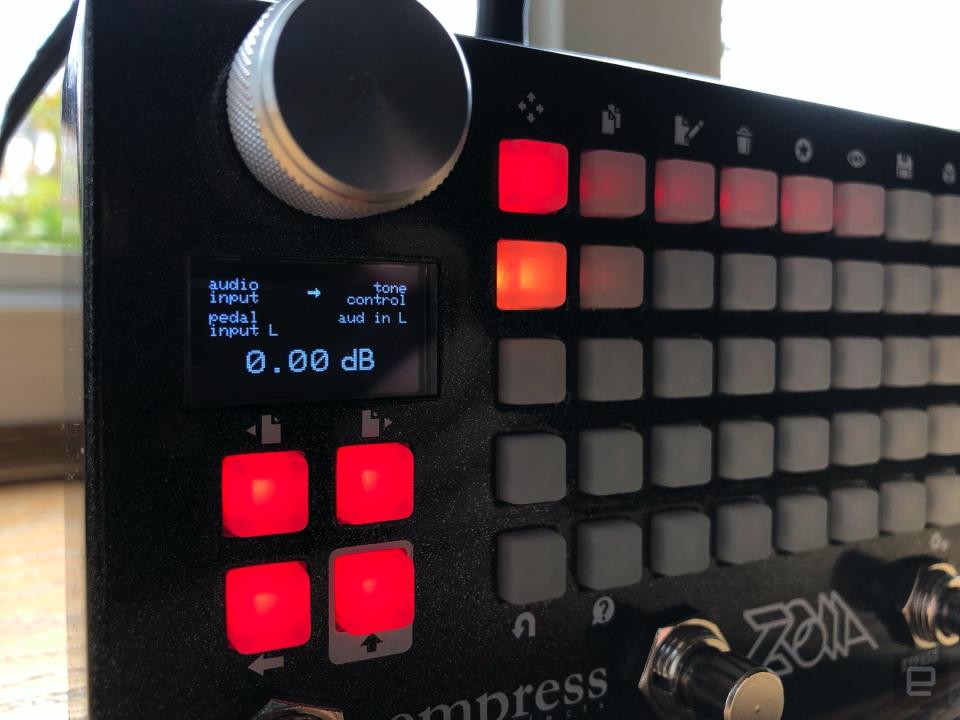
I’ll admit that when I first played with the ZOIA at the Brooklyn Stompbox Exhibit last summer, I was overwhelmed and confused. This little box made all sorts of crazy sounds, but standing in a crowded event space with dozens of other gear nerds wasn’t exactly conducive to getting a feel for the pedal.
Back at home, with time to explore (and, more important, a manual), things started to make sense.
Empress made a lot of clever design choices when it comes to the interface that make navigating it surprisingly easy once you’ve learned its quirks. Pressing an empty spot in the grid immediately brings the module-selection menu up on the small OLED screen. There are more than 80 to choose from (including more than 20 dedicated effects), but they’re broken down into commonsense categories, which make it pretty simple to find what you’re looking for. Different modules take up a different amount of space on the grid, with each button (or block) representing an input, an output or a variable that can be changed. You connect those various ins and outs by pressing the two buttons at the same time.
For instance, let’s say you want to build a simple reverb patch. First you’d lay out your modules on the grid by pressing buttons that are unlit and selecting an audio in, an audio out and a reverb (go with Lite to keep things simple). Assuming you’re putting a guitar through the pedal in mono, first you’d press the “pedal input L” button and, without letting go, press the “input L” button on the reverb module. Then you’d press and hold the “output L” block in the reverb module while pressing “pedal output L” in the audio-out module. (You could also change the modules to mono and remove the second inputs and outputs, but let’s keep things simple.)
Now you have a reverb: Congrats!
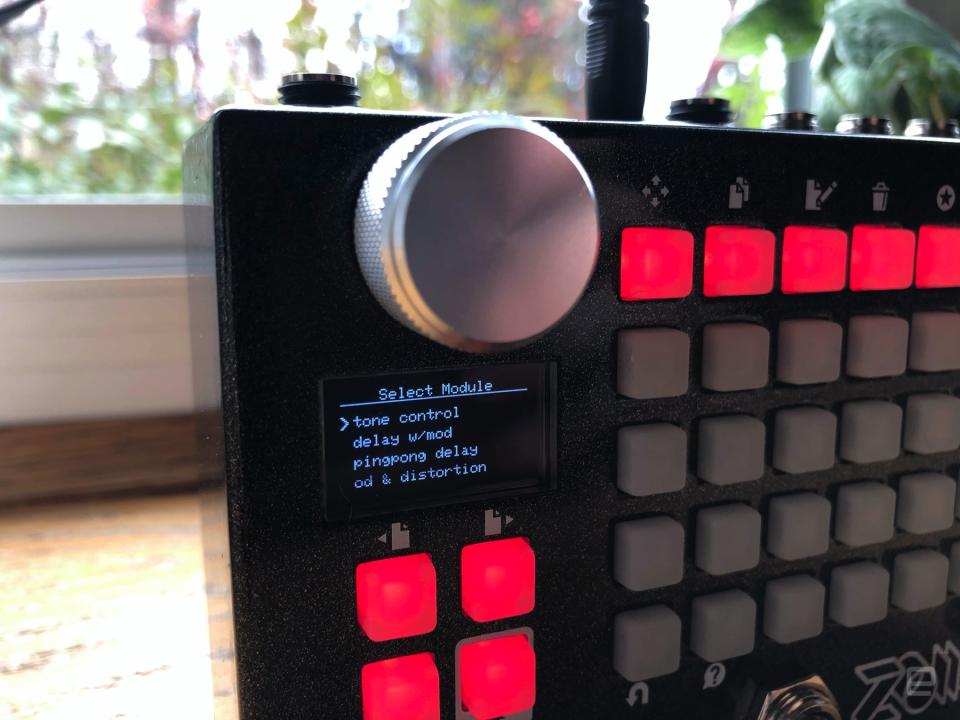
As you play, you’ll notice something: The lights of the audio in and audio out will brighten and flicker in response to your playing. They’re reflecting the actual amount of signal flowing through that particular block. This is true of all the various modules. If you press that third button in the Reverb Lite module, you’ll bring up the decay-time control. You change this by turning the one giant knob on the front. As you turn up the decay time, the block will brighten. Also, if you press in an input or output block on a module, the other blocks it’s connected to will light up (the output on the reverb and the pedal output, for instance).
In the abstract that might still sound like a confusing mess of lights, but it’s actually a pretty good way to visualize your signal as it flows through the pedal and helps quickly locate all the connections you’ve made in a patch.
But there are some limitations that no amount of clever design can overcome. The biggest (figuratively and literally) is that knob. To keep things pedalboard-friendly, some sacrifices had to be made, and while most effects pedals will have a number of knobs for tweaking parameters, the ZOIA has just one. So when you want to rein in those reverb tails, you’ll have to press the decay-time button and turn the encoder counterclockwise. Then, if you want to change the wet/dry mix, you’ll have to press that block and turn the knob again. It’s far from ideal, especially since it’s basically impossible to identify what a block does just by glancing at it. And on complex patches there can be dozens, or even hundreds, of variables to contend with.
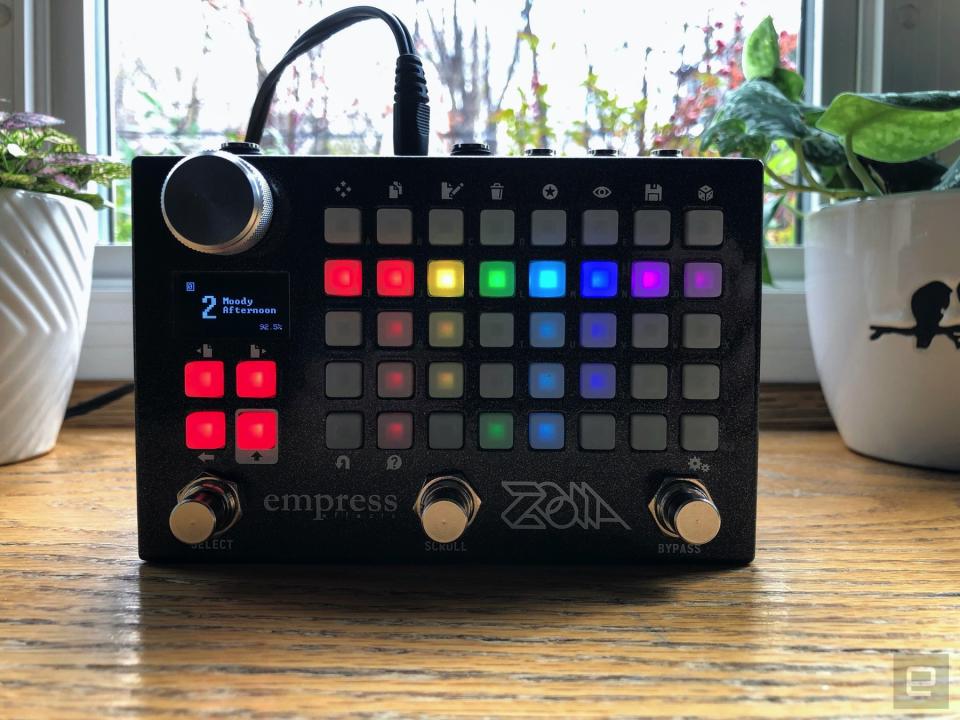
You can color-code the modules, which helps. But you’ll still need to remember which block controls what. Now, there are some advanced tricks that can make navigating settings easier, but that’s beyond the scope of this review.
What I will say is that patches on the ZOIA come alive when you worry less about tweaking knobs like you would on a traditional pedal and embrace its more unique automation features.
Let’s take our reverb patch: Right now it’s pretty boring. But what if we were to drop in an envelope follower? Connect the audio-in to the input, then connect the CV out (notice it uses the same language as modular synths) to the decay-time block on the reverb module. Now the harder you play, the longer the reverb tails will be. Instead of a boring, bog-standard reverb, you now have a dynamic effect that responds to your playing.
There are other ways to control the patches. For one, there’s a port for an expression pedal. That will let you change one or more parameters with your foot. You could use this in a traditional way like a wah or volume pedal. But you could also connect it to the wet/dry mix on a reverb and the feedback on a delay so that as you press the toe down, they both increase, causing cavernous repeats of your notes to pile up into a wall of noise until you rock the heel down.
Then there are the LFOs. You could slap down a simple sine wave and connect it to the speed of a vibrato so that the rate of the pitch fluctuations gets faster and slower over time. You could also put a sample and hold LFO on the width of that vibrato so that the amount of the pitch bends is changed to a random value (within a defined range) at a regular interval. Or, and bear with me here, you could connect an envelope follower to that random LFO so that the harder you play, the more frequently it changes the depth of the vibrato, creating an effect that gets more out of control as your playing gets more out of control.
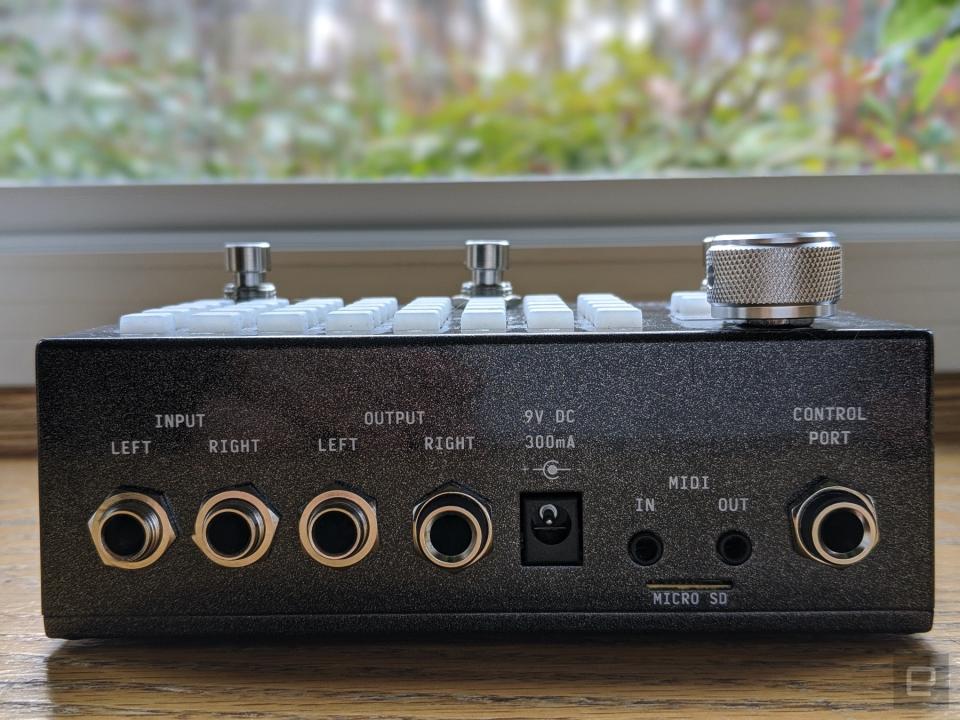
MIDI integration opens up a whole other level of control, and I’ve honestly barely scratched the surface there. Most obviously you can connect a keyboard and play a synth patch. (There is a simple keyboard module that allows you to play the ZOIA physically.) But you could also connect a knob-heavy controller like the MIDI Fighter Twister or a Novation Launch Control and use that to tweak your patches. Or connect a sequencer and use that to change parameters or turn on and off various parts of a patch at predetermined times. You could even use the MIDI out on the ZOIA to trigger an external sequencer by stomping on one of its three foot switches, which in turn triggers changes on the ZOIA.
Control options
In this patch an expression pedal is controlling the feedback amount, modulation rate, and modulation depth on a delay.This patch is a polyphonic string synthesizer with 4 LFOs being played using an external MIDI controller.
Things can get pretty complicated pretty quickly if you want them to. And this is where you start to brush up against the limits of the ZOIA’s interface. Our simple reverb patch is easy enough to navigate. But more complicated ones can be difficult to decipher, especially if you didn’t build them yourself. As the pages of modules pile up, keeping tabs on your connections and tracking down the parameters gets harder and harder.
A desktop editor or even just an app for sketching out patches before you commit them to the device would be a huge help. Empress said it has no intentions of creating such a thing, but the company is working on opening up the code to developers so that if someone else wants to build that app, they can.
Honestly though, you can build pretty complex patches before things get out of hand. After just a couple of days with the ZOIA, I had built an effect that was inspired by what an old sampler might sound like as it died. It’s not the most complicated ZOIA patch I’ve seen, but it’s far from a simple reverb.
Broken Sampler
In this patch a bit crusher and aliaser are combined to create a crunchy vibe similar to a ’90s-era MPC. An LFO applied to the aliasing amount gives it a sense of instability and creates waves of digital artifacts. There are two additional effects that can be turned on and off: a shallow vibrato connected to an envelope follower and a granular module (with the grain size connected to a sample and hold LFO) that introduces glitching and stuttering for full meltdown mode. Last, one of the foot switches momentarily freezes the granular buffer to create chaotic bursts of repeats.
Of course, you don’t have to build your own patches. There is an active community sharing their creations on Patchstorage. I’ve lost count of how many were posted there, but it’s well in excess of 500. They run the gamut from surprisingly solid overdrives and fuzzes to ambient reverbs, modulated madness and self-playing synths. There are even patches inspired by boutique effects pedals and vintage synths. The ability to give some more obscure effects a spot on my pedalboard through emulation has been huge. I stuck a recreation of Fairfield Circuitry’s Shallow Water at the end of my signal chain, and I’ve had such a hard time turning it off that I’ve decided I have to have one for real now. (The ZOIA may end up being very bad for my wallet…)
One of my favorite uses, though, has been as a chaotic and experimental looper or delay pedal. Patches like Loop Forest, JohannLooper and Rephrase can take even simple melodic ideas and immediately turn them into evolving rich compositions. At times, it feels like cheating.
Some of my favorite patches
Deep Water by virtualpt
Alterneath V4, Neutron Star and Rephrase by [WZ]
Loop Forest by Red Means Recording
Tape Landscape by DGAFStevie
JohannLooper, Fading dream, and Swollen Sky by Christopher HM JacquesHere an arpeggiated synth is paired with JohannLooper and a sampled piano is played through Loop Forest.
Managing all these patches, though, is tedious. Again, there’s no app. No desktop library. Instead you copy patches to an included microSD card, using a specific naming convention, then choose “Patches from SD” in the settings menu. The ZOIA can only hold 64 patches at a time, and you have to manually change the names of files to make sure you don’t overwrite ones you want to keep.
Let’s say you’ve downloaded Loop Flux from Patchstorage. The file you get from there starts with “022.” That means it will be loaded in the 22nd preset slot. But what if you have an epic washy reverb you love there and instead you want to replace the flanger in slot 46 that you never use? Well, you have to change the file name from “022_zoia_Loop_flux.bin” to “046_zoia_Loop_flux.bin.” It’s not rocket science, but it can get frustrating to keep track of the patches you want, the ones you don’t and what slots you’ve loaded them into.
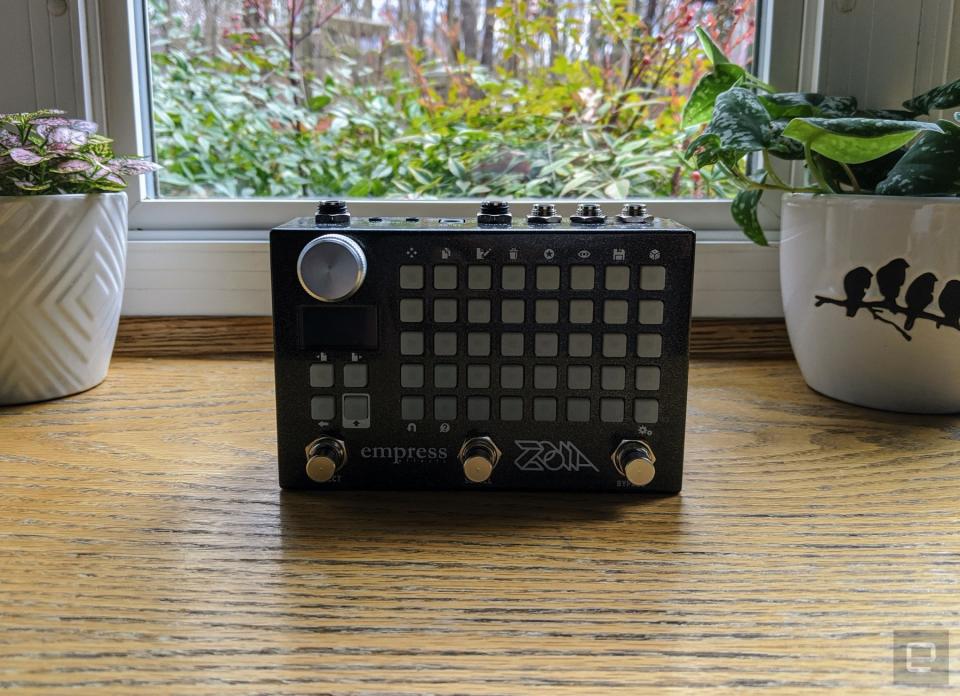
Normally this is where I lay out the competition and tell you how it stacks up. But there isn’t much direct competition out there. Perhaps the closest are the MOD Dwarf and the Poly Effects Digit. The Dwarf is $369, compared to the ZOIA’s $499. But it doesn’t have the same synth-based bones and is ultimately a pretty traditional multi-effects pedal — just with a much larger library of effects and an extremely flexible routing system. More important, though, it’s not shipping yet. Its creators successfully wrapped up a Kickstarter campaign in early April, but the usual caveats apply about any crowdfunded device.
Similarly the $399 Digit is a relatively straightforward multi-effects pedal, albeit one with intricate routing options and onboard LFOs. Its biggest feature is a five-inch touchscreen. That makes programming it much easier than programming the ZOIA or the Dwarf, but personally, I’d be afraid to put a display of that size anywhere near my clumsy, boot-covered feet.
Then there are high-end multi-effects units like the Eventide H9, which costs anywhere from $499 to $699. They sound amazing but don’t give you the ability to design your own effects.
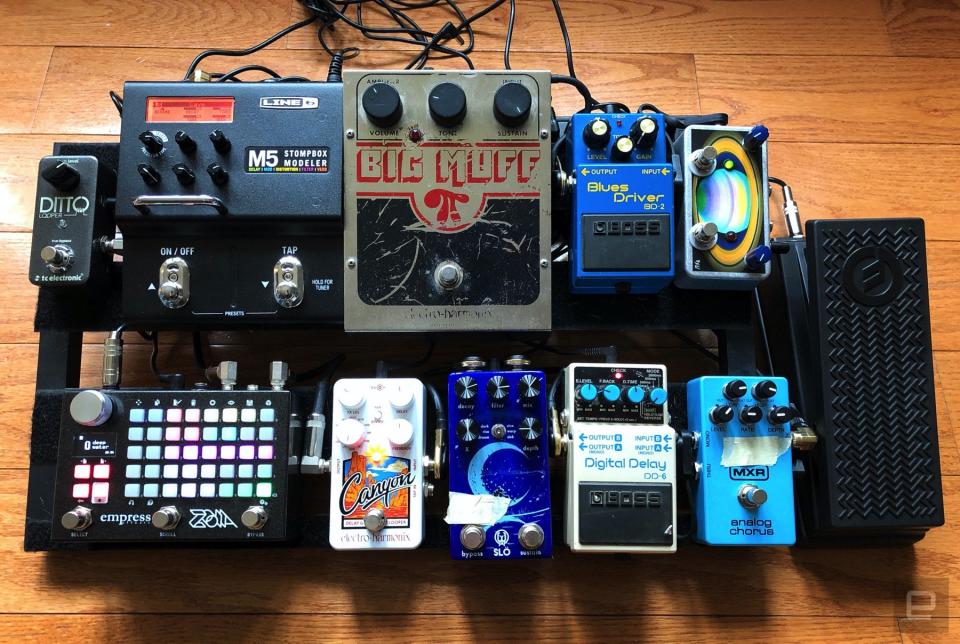
That brings me back to my original point: The ZOIA is one of a kind. It’s not the most user friendly. But it is unique. And if you’ve ever dreamed of designing your own effects but don’t want to breadboard a new circuit every time you get an idea, then the ZOIA is unquestionably for you. If you’re just looking for standard-effects-pedal fair, then the ZOIA is probably overkill. It’s certainly capable of great choruses and ripping fuzz, but its true worth is in delivering hundreds of different strange and unexpected effects to your pedalboard. It’s entirely possible that after using it, all other stompboxes will seem boring.

